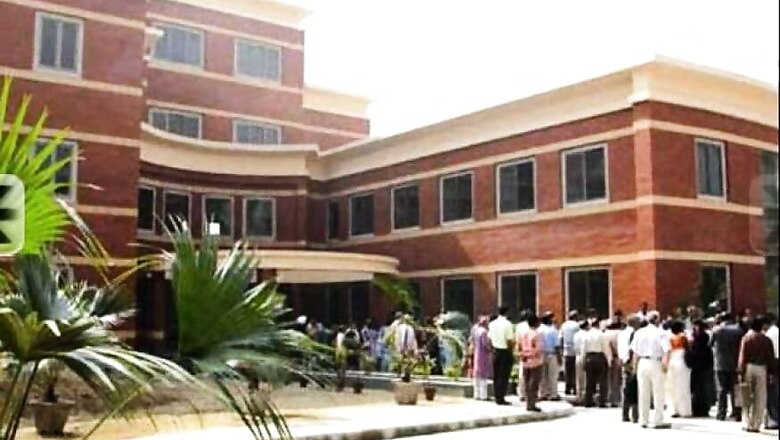
views
Delhi University Students’ Union (DUSU) results were out last week. With dust having settled, the parties should be concerned at the voting pattern, which is not moving beyond caste and regional commitments and the rapid increase in the apolitical voters pressing the NOTA (none of the above) button.
The Gujjar students remained with the Rashtriya Swayamsevak Sangh (RSS)-affiliated Akhil Bharatiya Vidyarthi Parishad (ABVP) and the Jats with the Congress-backed National Students’ Union of India (NSUI). Where the NSUI lost out was the Jat votes cut by Indian National Students Organisation (INSO), the enterprise of the Chautala family of Haryana.
The ABVP candidate for vice president, Shakti Singh, by polling over 23,000 votes, became the highest aggregator, illustrating once again the political ambitions of the migrant voters from the Hindi-speaking states in the city.
The DUSU results would give some ammunition to Delhi Congress president Ajay Maken, himself a former DUSU president, to keep up his resistance for any alliance with the AAP. Maken has taken the position that AAP was fast losing ground and the party did not stand to gain anything from an alliance with them.
The political protests in the national capital in the past few weeks have also shown AAP’s dilemma whether agree to be a junior partner in a Congress-led alliance or seek a pound of flesh in accordance with the large number of seats it presently holds in the Delhi assembly.
Chief minister Arvind Kejriwal ensured that he did not share dais with Congress president Rahul Gandhi while joining a protest led by Rashtriya Janata Dal (RJD) leader Tejashwi Yadav. However, a few days later, after having announced its non-participation in the Congress-called ‘Bharat Bandh’ earlier this month, AAP leaders finally joined the march, albeit sheepishly.
The entry of ruling Aam Aadmi Party (AAP)-affiliated Chattra Yuva Sangharsh Samiti (CYSS) in the contest failed to make the polls into a triangular fight. The NSUI and ABVP locked horns for all the four posts. The third player remained a distant third and they could make their existence felt largely because the CYSS had entered into an alliance with the ultra-Left All India Students’ Association (AISA), which has a visible cadre presence on the campus.
This alliance was knitted by AAP’s de facto education minister Atishi Marlena (the surname which she has recently dropped). After the defeat, AAP leaders claimed poll results were no reflection on the city politics, despite the fact that Atishi led the alliance in the polls from the front. The AAP government, just ahead of the polls, also announced allowing the Delhi Transport Corporation’s Student Pass on its fleet of the air-conditioned buses.
Distribution of freebies did not remain restricted to AAP, union minister of housing and urban affairs Hardeep Puri promised a subsidised rise for the students on the Delhi Metro. It goes without saying that he was making the promises for the ABVP panel. Now that ABVP has won three of the four seats, Puri would have to burn midnight oil on how to make his promise come true.
Despite best efforts to create awareness by the media, the voting percentage in the elections failed to even get close to 50 per cent. When poll percentage somewhat went up this time, people little realised what was in store. The large number of votes polled by category has stumped all. Of the total votes polled for all four posts, NOTA alone got 27,739 votes. NOTA votes polled for each post were: President — 6211, VP – 6445, Secretary -6810 and Joint Secretary – 8273. For the secretary’s posts, NOTA had more votes than the AAP-backed CYSS candidate.
Ahead of the elections, it was mentioned in these columns on how the DUSU elections have metamorphosed from being a contest between ideologies to a wrestle between caste combination as the butterfly effect of the admission quota introduced in Delhi University for applicants from the Other Backward Classes (OBCs) during the UPA-I regime by then human resource development minister Arjun Singh.
This perception has stood its ground. The graduation of these caste leaders from the university to the city politics is a natural course. That many do not manage to complete graduation degree is another matter. This brings us to the issue of frustration among the educated youth towards politics.
Extrapolating these results to analyse city politics and also national political mood, it is bad news for the political leaders – Narendra Modi, Rahul Gandhi and Arvind Kejriwal alike. The young people from the educated middle class families coming out to vote and then pressing the NOTA button is a clear indication, not only about their disenchantment with the government policies and also still remaining indifferent towards Rahul Gandhi’s push, but more importantly losing faith in symbols of ‘alternative politics’.
While they may not be yet ready to vote for the Congress in large numbers, and definitely not the groups preaching ‘alternative politics’, the educated youth of the country for sure is trying to sound Prime Minister Narendra Modi that his reforms are pinching people hard, especially the urban middle class. No wonder, BJP president Amit Shah’s strategy for 2019 is increasingly getting focused on booth management than mass mobilisation.
(The author is a senior journalist. Views are personal)




















Comments
0 comment